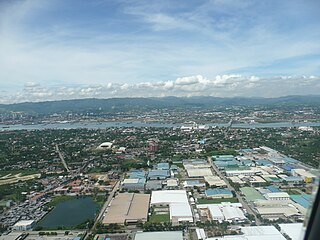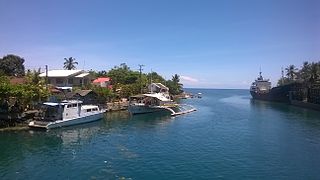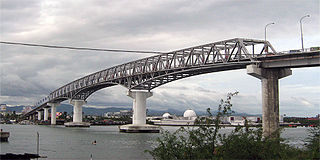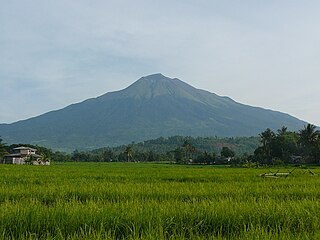
A city is one of the units of local government in the Philippines. All Philippine cities are chartered cities, whose existence as corporate and administrative entities is governed by their own specific municipal charters in addition to the Local Government Code of 1991, which specifies their administrative structure and powers. As of September 7, 2019, there are 146 cities.

Lapu-Lapu City, officially the City of Lapu-Lapu, is a 1st class highly urbanized city in the Central Visayas region of the Philippines. According to the 2020 census, it has a population of 497,604 people.

Mandaue, officially the City of Mandaue, is a 1st class highly urbanized city in the Central Visayas region of the Philippines. According to the 2020 census, it has a population of 364,116 people.

Liloan, officially the Municipality of Liloan, is a 1st class municipality in the province of Cebu, Philippines. According to the 2020 census, it has a population of 153,197 people. Liloan lies within Metro Cebu.

Metropolitan Cebu, or simply Metro Cebu,, is the main urban center of the province of Cebu in the Philippines. Metro Cebu is located along the central eastern portion of the island including the nearby island of Mactan. It accounts for 19.9 percent of the land area and 61.5 percent of the population of the entire province of Cebu.
The Legislative districts of Cebu are the representations of the province of Cebu and the highly urbanized city of Mandaue in the various national legislatures of the Philippines. The province and city are currently represented in the lower house of the Congress of the Philippines through their first, second, third, fourth, fifth, sixth, and seventh congressional districts.
The Mantawi Festival is an annual festival celebrated every on May 7th in Mandaue City in Cebu, Philippines.

The Mactan–Mandaue Bridge, officially the Sergio Osmeña Bridge, is a truss bridge that connects the cities of Mandaue and Lapu-Lapu in Metro Cebu, Philippines. It is one of two bridges that spans across the Mactan Channel, the other being the Marcelo Fernan Bridge, and connects the islands of Cebu and Mactan.

The University of the Visayas (UV) is a private institution located in Cebu City, Philippines. It is the first school in the province of Cebu to attain university status.

Jonas Cabungcal Cortes is a Filipino politician serving as the Mayor of Mandaue City since 2019, a position he previously held from 2007 to 2016. He previously served as representative of the sixth district of Cebu from 2016 to 2019.

The Mayor of Mandaue City is the head of the Local government of the city. Since the Pre-Hispanic time were chiefs, only two are known Aponoan and Lambuzzan. Not many people are mentioned in the Spanish Expedition chronicles; the former was succeeded by the latter. During the year 1600 when the Spanish subjugated Mandaue Andug was the chief of the settlement. Before there were priests, Capitanes, Tenientes and the Cabeza de Barangay were the local leaders in Spanish regime. Later, in the American commonwealth era of the Philippines the leaders were the President and after the war the title changed to Mayor. Mandaue was only incorporated as a city on June 21, 1969 in the term of Mayor Demetrio Cortes Sr. which led to the signing of the City Charter on August 30, 1969 under Republic Act No 5519.
Thadeo "Teddy" Zambo Ouano is a Filipino politician served as mayor of Mandaue from 1998 until 2007.
Mandaue is a city in the province of Cebu in the Philippines. In pre-Hispanic times it was ruled by a chieftain, Aponoaan, who gave tribute to the Spanish. A later chief was Lambusan but after the arrival of the Spaniards, the Jesuit priests were given authority. Local leaders during the Spanish regime were Capitanes, Tenientes and the Cabeza de Barangay. In the American commonwealth era of the Philippines the leaders were the El Presidentes of Mandaue. In 1943, after the war, the title was changed to Mayor.

Negros is the fourth-largest and third-most populous island in the Philippines, with a total land area of 13,309 km2 (5,139 sq mi). Negros is one of the many islands that comprise the Visayas, in the central part of the country. The predominant inhabitants of the island region are mainly called Negrenses. As of 2020 census, the total population of Negros is 4,656,945 people.

Central Visayas is an administrative region in the Philippines, numerically designated as Region VII. It consists of four provinces: and three highly urbanized cities: Cebu City, Lapu-Lapu, and Mandaue).
Sotero "Terong" Barte Cabahug was a Filipino lawyer, legislator, politician, and civil servant from Mandaue, Cebu, Philippines. He was awarded Legion of Honor with the rank of Commander. He was governor of Cebu (1934–1937), member of the House of Representatives for Cebu's 2nd district for two consecutive terms (1928–1934), Secretary of Public Works and Communications (1945–1946), member of the Cebu Provincial Board (1952–1954), the 9th Secretary of National Defense (1954–1956), and associate justice of the Court of Appeals (1956–1961).
Jesus Marino "Rene" Gandiongco Espina was a Filipino lawyer, legislator, and politician. He served as Governor of the province of Cebu, Philippines (1963–1969) and Senator (1970–1973).

Cebu's 6th congressional district is one of the seven congressional districts of the Philippines in the province of Cebu. It has been represented in the House of Representatives of the Philippines since 1916 and earlier in the Philippine Assembly from 1907 to 1916. The district consists of the city of Mandaue and adjacent municipalities of Consolacion and Cordova. It is currently represented in the 18th Congress by Emmarie M. Ouano-Dizon of the PDP–Laban.

Emmarie "Lolypop" Ouano-Dizon is the congressional district representative of the Cebu's 6th Congressional District of the 18th Congress of the Philippines.
Cebu's at-large congressional district was the provincewide electoral district used to elect members of Philippine national legislatures in Cebu before 1987.











